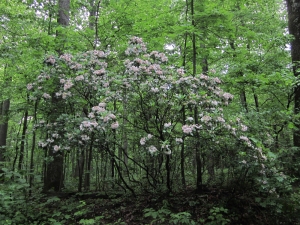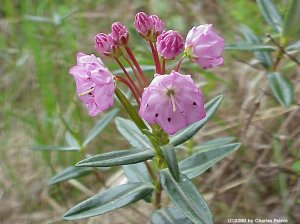I grew up enjoying the site of mountain-laurel blooming in profusion each June. It is a common understory shrub in the Hudson Highlands, one of the northeast-southwest-trending chains of mountains that make up the northern Appalachians through downstate New York. Kalmia latifolia is an evergreen member of the Ericaceae (heath family), but it is definitely most noticeable when it flowers. The pink-tinged white blossoms are arranged in corymbs; the petals are attached to form pentangular bowls. The corymbs are several inches across; each flower is about an three-quarters to an inch in diameter. It is a showy plant.

In addition to their large size, the flowers are set against glossy, dark green foliage. K. latifolia has the tendency to form large, continuous thickets, sometimes covering part of an acre on rocky, well drained hillsides. In the southern Appalachians, they can attain the size of a small tree (over 20 feet tall), but in the northeastern states they are usually five or six feet tall.
I haven’t seen any mountain-laurel on Martha’s Vineyard yet, but it does occur here and is likely to be found “up-island” in the towns of West Tisbury, Chilmark, and Aquinnah. The Gay Head and Martha’s Vineyard Moraines create a series of northeast-southwest-trending ridges that form the upland portion of the island. The terrain is dotted with large boulders (especially in the Gay Head Moraine areas) and was apparently originally forested with more beeches and maples (Northern Hardwood assemblage), tempering the dominant Oak-Heath presence that still dominates the down-island portion of the island, which a sandy outwash plain formed by the erosion of the moraine.

The most common member of the heath family in the outwash plain is the sheep-laurel, Kalmia angustifolia. This is a much smaller plant than K. latifolia, getting only about three feet all, but it has the same tendency to grow in extensive thickets. It is a common part of the Oak-Heath assemblage wherever it is found. It has evergreen leaves that hang down at a sharp angle. As its trivial name implies, the leaves of sheep laurel are narrow. It can also be distinguished from other Kalmia species because its branches end in terminal whorls of leaves, while the flowers emerge from the stem beneath the terminal leaves. The flowers resemble those of mountain laurel, but are a deep pink and much smaller.
The third member of the genus that is found in the northeastern U.S. is Kalmia polifolia, the bog-laurel. While the other two species are associated with mesic or even dry habitats, K. polifolia lives up to its name and is strongly associated with hydric conditions, although not necessarily bogs. K. polifolia is distinguished from K. angustifolia by the position of its flowers, which are terminal rather than growing further down the stem like the sheep-laurel’s. K. polifolia also blooms in the spring (April or May) rather than in the early summer.

All Kalmia prefer acidic soil conditions. But while sheep-laurel grows on a variety of sites ranging from wet sphagnum bogs to dry jack pine forests, bog-laurel is confined to wetlands (it is also called “swamp-laurel”). Mountain-laurel, on the other hand, prefers drier sites, but can tolerate moist soils at the edges of wetlands. While the sheep-laurel is widespread on Martha’s Vineyard, the bog-laurel is not found here at all.
The fourth member of the heath family found in the Northeast is Kalmia procumbens, the alpine-azalea, but as its name suggests, it is confined to the tundra-like areas on the higher peaks of New Hampshire and Maine and grows to be only 4 inches tall.
All parts of all members of the genus are poisonous to many mammals. The sheep-laurel gets its name for its morbid effect on that species, but the plant is poisonous to all livestock, as well as to humans. Some mammals, caribou for example, can tolerate it, and many birds depend on the fruits for winter forage.
